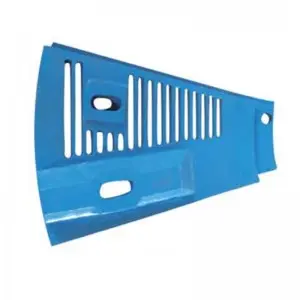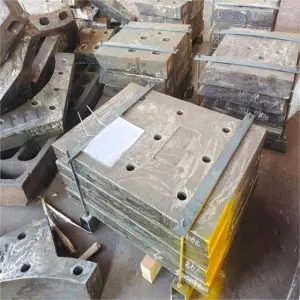As the core equipment for material crushing, the grinding liner inside the cylinder of the ball mill seems to be just a protective structure, but in fact, it is the core component that determines the grinding efficiency, equipment service life and product quality. In the grinding of iron ore in mineral processing, high-quality liners can increase the hourly output of the ball mill by 15%. In the clinker grinding stage of cement production, the appropriate liner can reduce the unit power consumption by 8-10 KWH /t. The mill liner, by balancing the dual roles of “protection” and “efficiency enhancement”, becomes an invisible pillar for the stable operation of the ball mill. This article analyzes how mill liners support the efficient operation of ball mills from three dimensions: functional mechanism, material compatibility, and maintenance strategies.
Function: Full-process control from protection to grinding
The most fundamental function of the grinding mill liner is to build a “protective barrier for the cylinder”. When the ball mill is in operation, the impact kinetic energy between the grinding medium (steel balls, steel segments) and the material can reach over 1000J. Without the protection of the liner, the steel plate of the cylinder will show obvious wear (with a thickness reduction of 2-3mm) within 300 hours. However, after installing the liner, the service life of the cylinder can be extended to more than 5 years. The liner absorbs over 30% of the impact energy through its own deformation, reducing the impact force on the cylinder from 200MPa to below 50MPa and preventing the cylinder from cracking due to fatigue stress.
The deeper function lies in “regulation of the grinding process”. The surface shape of the liner directly affects the movement trajectory of the grinding medium: The wavy liner can make the steel balls form a “throwing – impact” movement pattern, which is suitable for the crushing of brittle materials (such as quartz sand). The stepped liner guides the steel balls to perform a “rolling – squeezing” movement, which is more suitable for grinding tough materials such as clay. The production data of a certain gold mine shows that after replacing the flat liner plate with a corrugated liner plate, the proportion of -200 mesh particles in the gold ore powder increased from 65% to 82%, significantly improving the gold leaching rate.
The liner can also optimize the material flow rate through structural design. In a multi-chamber ball mill, the front chamber liner adopts a short-stroke design (with a lifting height of 10-15cm) to accelerate the passage of materials through the coarse grinding stage. The rear chamber adopts long-stroke liners (with a lifting height of 20-25cm), which extends the fine grinding time and makes the particle size distribution of the product more uniform. This segmented regulation capability enables the ball mill to maintain stable grinding efficiency even when processing multi-component mixed materials.

Material: Wear-resistant solution selected based on working conditions
The material selection of the mill liner needs to precisely match the material characteristics and grinding intensity. Liners of different materials show significant differences in wear resistance, toughness and cost. High manganese steel liners (Mn13Cr2) have become the preferred choice for processing high-hardness ores such as granite and basalt due to their rapid surface hardening (hardness rising from HB200 to HB500) after impact. Their service life in metal mines can reach 800 to 1200 hours, which is three times longer than that of ordinary carbon steel liners.
High-chromium cast iron liners (Cr15Mo3) perform better in low-impact and high-wear scenarios. In the cement raw material mill, its anti-abrasive wear performance is 50% higher than that of high manganese steel. It is especially suitable for processing materials containing quartz sand (with quartz hardness reaching 7 on the Mohs scale), and the replacement cycle of the single-bin liner can be extended to 1500 hours. However, high-chromium cast iron has relatively low toughness. In large ball mills (with a diameter > 4.2m), it needs to be used in combination with steel backs to avoid impact fracture.
Rubber liners offer alternative solutions for specific scenarios. In wet grinding (such as grinding before cyanide leaching of gold), rubber liners (Shore hardness 60-70A) can reduce the mechanical loss of gold particles by steel balls, increasing the gold recovery rate by 1-2 percentage points. Its weight is only 1/5 of that of steel liners, which can reduce the starting load of the ball mill and save more than 10% of the motor power. However, the rubber liner has limited temperature resistance (≤80℃) and is not suitable for grinding high-temperature materials such as cement clinker.
For special industries, functional material liners are indispensable. In the grinding of magnetic materials, the use of non-magnetic steel liners (with magnetic permeability < 1.01) can prevent the mixture of ferromagnetic impurities. In the grinding of food additives, 316 stainless steel liners (containing 2-3% molybdenum) can withstand acid and alkali cleaning and meet FDA hygiene standards.
Structural design: The efficiency code for adapting to working conditions
The structural parameters of the liner need to be deeply coupled with the specifications of the ball mill and the characteristics of the materials. The thickness of the liner is usually 2 to 3 times that of the cylinder steel plate (15-50mm). The liner in the coarse grinding chamber is relatively thick (30-50mm) to resist the impact of large steel balls (100-120mm in diameter), while the liner in the fine grinding chamber is thinner (15-25mm) to reduce the occupation of grinding space. The connection between the liner and the cylinder adopts a structure of “countersunk bolts + elastic washers”, with the bolt preload controlled at 300-500N · m, which not only ensures a tight fit but also compensates for thermal expansion and contraction during operation.
Surface configuration is at the core of structural design. The height of the lifting bar (the protruding part on the surface of the liner) directly affects the lifting height of the grinding medium: the height of the lifting bar in the coarse grinding chamber is 80-100mm, which enables the steel balls to have a greater drop height and generates a strong impact force to break large pieces of materials. The height of the lifting bar in the fine grinding chamber is 40-60mm. The steel balls mainly roll to achieve fine grinding of the materials. The practice of a certain copper mine shows that after adjusting the height of the lifting bar in the coarse grinding bin from 80mm to 95mm, the crushing efficiency of copper ore increased by 12%.
The block design is related to the efficiency of installation and maintenance. For large ball mills (with a diameter of over 5 meters), the weight of each liner is controlled within 50 kilograms. They adopt a wedge-shaped lap structure, eliminating the need for overall alignment during installation. The replacement time for a single compartment is shortened to 8 hours. For small ball mills (with a diameter of less than 2.4m), full-circle arc-shaped liners can be adopted to reduce the number of seams and lower the risk of material jamming. The corner rounding treatment of the liner plate (with a radius of 5-10mm) can prevent stress concentration and extend its service life by 20%.

Maintenance and care: A scientific strategy for extending lifespan
The maintenance of grinding mill liners requires the establishment of a “prevention first” management system. During routine inspections, it is essential to focus on checking the tightness of the liner bolts. When the loosening of the nuts exceeds 1mm, they should be tightened immediately to prevent secondary wear caused by the liner’s movement. Measure the remaining height of the lifting bar every week. When it wears down to one-third of its original height, formulate a replacement plan to avoid affecting product quality due to a decline in grinding efficiency.
Regular flipping and use is an effective way to extend the service life of the liner plate. Bidirectional symmetrical structure liners (such as rhombic and square ones) can be flipped 180° and continue to be used after wearing 20mm on one side, which extends the total service life by 50%.
The choice of the timing for replacement directly affects the overall benefits. Excessive wear of the liner (with the remaining thickness less than 50% of the original thickness) will cause the grinding efficiency to drop by more than 30%. Continuing to use it at this point will instead increase energy consumption. However, premature replacement leads to material waste. Through the online monitoring system (stress sensors installed on the back of the liner), wear data can be obtained in real time. When the impact energy absorption efficiency drops to 70% of the initial value, it is the best replacement node.
The technological iteration of grinding mill liners has always revolved around the goal of “high efficiency, wear resistance and low cost”. From high manganese steel to composite materials, from flat to bionic structures, each upgrade has driven the ball mill to develop in a more energy-efficient and precise direction. For equipment users, understanding the matching logic between the liner and the grinding process, choosing the appropriate material and structure, and doing a good job in daily maintenance can enable this key component to truly play its value and support the efficient operation of the ball mill in various industrial fields.
Post time: Jul-17-2025
